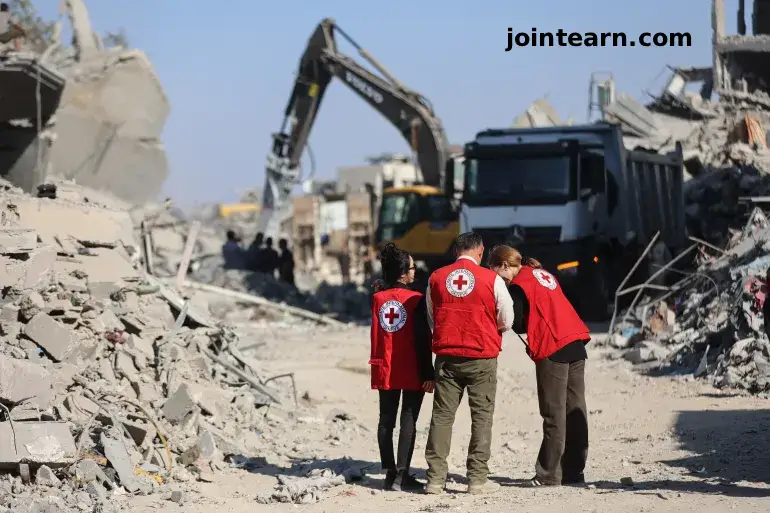
Gaza City, October 27, 2025 — The Palestinian group Hamas has transferred the remains of another Israeli captive to the International Committee of the Red Cross (ICRC) for return to Israel, even as an Israeli drone strike killed two Palestinians in southern Gaza, threatening to destabilize a fragile U.S.-brokered ceasefire.
The Israeli military confirmed late Monday that the Red Cross was transporting the coffin containing the body of the captive to Israeli forces stationed inside Gaza. The exchange comes amid growing tensions between both sides and rising frustration among families of the deceased captives.
Truce Under Strain as Hamas Returns Remains of Deceased Captives
Under the October 10 ceasefire agreement, brokered by the United States, Egypt, and Qatar, Hamas pledged to return the bodies of all 28 deceased Israeli captives while releasing the 20 surviving hostages, who were freed on October 13. As of Monday, 16 sets of remains had been handed over to Israel.
Despite the ongoing exchange, families of the remaining captives are calling for the Israeli government to halt further negotiations unless Hamas fulfills its full obligation.
“Hamas knows exactly where every one of the deceased hostages is held,” the Hostages and Missing Families Forum said in a statement. “The families urge the government of Israel and mediators not to advance to the next phase until every hostage is returned.”
Israeli officials have echoed these claims, asserting that Hamas has knowledge of the burial sites but is delaying the process for political leverage.
Hamas Cites “Challenges” in Locating Bodies
In response, Hamas negotiator Khalil al-Hayya said on Saturday that the group faces significant challenges in locating the captives’ remains, blaming the extensive destruction in Gaza caused by Israel’s military operations.
“The occupation has altered the terrain of Gaza,” al-Hayya said, suggesting that those who buried the captives may have been killed during Israeli air raids, or that some burial sites were lost under rubble.
Following these remarks, Israel authorized an Egyptian technical team to enter Gaza to assist in the search. The team, equipped with excavators and heavy machinery, is working alongside Palestinian volunteers to recover bodies believed to be buried in collapsed buildings.
Drone Strike and Rising Tensions Despite Ceasefire
Despite the ceasefire, Gaza’s Ministry of Health reported that an Israeli drone strike near Khan Younis killed at least two Palestinians and injured several others on Monday. Over the past 48 hours, Israeli attacks have killed eight people and wounded 13 others across the enclave.
Since the war began in October 2023, Israeli assaults have killed more than 68,500 Palestinians and injured 170,000, according to Gaza’s health authorities.
Speaking aboard Air Force One, U.S. Secretary of State Marco Rubio defended Israel’s actions, insisting the drone strike did not violate the truce.
“We don’t view that as a violation,” Rubio said. “If there’s an imminent threat to Israel, they have the right to act — all the mediators agree with that.”
Humanitarian Crisis Persists Despite Truce
In the two weeks since the ceasefire took effect, the United Nations estimates that 473,000 displaced Palestinians have returned to northern Gaza, only to find widespread destruction and critical shortages of food, water, and medical care.
Younis al-Khatib, president of the Palestine Red Crescent Society, emphasized the psychological toll of the war, saying:
“Rebuilding human beings is more difficult than rebuilding destroyed homes.”
He called for urgent mental health support, especially for children traumatized by years of bombardment and displacement.
The World Health Organization (WHO) warned that the number of Palestinians requiring mental health care has more than doubled, from 485,000 to over one million since 2023.
According to UNICEF, nearly all children in Gaza now need psychological assistance after enduring two years of relentless conflict.
“A classroom of children was killed every day for two years,” said Tess Ingram, UNICEF’s spokesperson in Gaza. “The scars of what these children have endured will last for many years to come.”
A Ceasefire on the Brink
As both sides continue to accuse each other of violations, the fragile ceasefire remains under immense strain. Analysts warn that continued drone strikes and disputes over the hostage recovery process could unravel the truce entirely, plunging Gaza back into full-scale warfare.
For Gaza’s civilians, however, the fear is that peace remains distant and the humanitarian crisis irreversible.
“Gaza is no longer just a war zone,” one aid worker said. “It’s a place where entire generations are being erased — not only by bombs but by despair.”
Leave a Reply